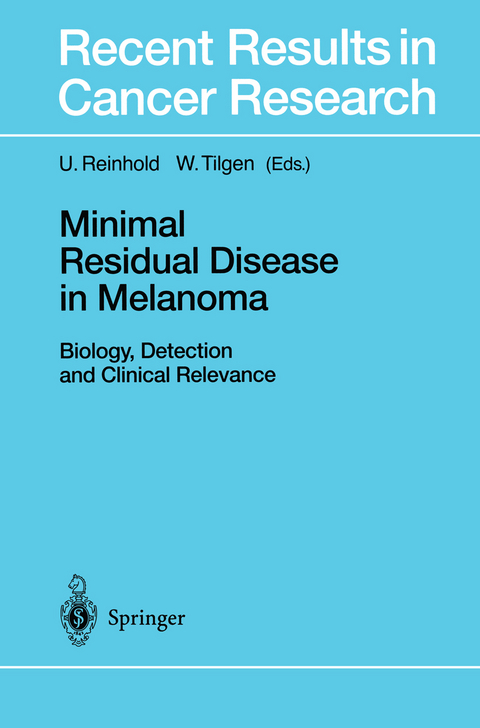
Minimal Residual Disease in Melanoma
Springer Berlin (Verlag)
978-3-642-64015-5 (ISBN)
I Biology of Micrometastases and Advances in Methods for Detection.- The Biology of Melanoma Micrometastases.- Disseminated Tumor Cells: Diagnosis, Prognostic Relevance, and Phenotyping.- Nested Quantitative Real Time PCR for Detection of Occult Tumor Cells.- Detection of Micrometastasis Through Tissue-Specific Gene Expression: Its Promise and Problems.- Immunobead-Based Detection and Characterization of Circulating Tumor Cells in Melanoma Patients.- Rapid Enrichment and Detection of Melanoma Cells from PBMC by a New Assay Combining Immunomagnetic Cell Sorting and Immunocytochemical Staining.- II. Detection of Residual Melanoma Cells in the Peripheral Blood and Bone Marrow.- Reverse Transcriptase Polymerase Chain Reaction (RT-PCR) Detection of Melanoma-Related Transcripts in the Peripheral Blood and Bone Marrow of Patients with Malignant Melanoma. What Have We Learned?.- The Clinical Utility of Multimarker RT-PCR in the Detection of Occult Metastasis in Patients with Melanoma.- Polymerase Chain Reaction in the Detection of Circulating Tumour Cells in Peripheral Blood of Melanoma Patients.- Facts and Pitfalls in the Detection of Tyrosinase mRNA in the Blood of Melanoma Patients by RT-PCR.- Morphologically Intact Melanoma Cells May Be Detected in Peripheral Blood of Melanoma Patients.- Prognosis of Metastatic Melanoma: No Correlation of Tyrosinase mRNA in Bone Marrow and Survival Time.- III. Detection of Minimal Residual Disease in Sentinel Nodes.- The Predictive Value of the Sentinel Lymph Node in Malignant Melanomas.- Detection of Micrometastasis in Sentinel Lymph Nodes of Patients with Primary Cutaneous Melanoma.- IV. Early Recognition and Monitoring by Serological Markers.- Monitoring Malignant Melanoma with the S-100B Tumour Marker.- Melanoma Inhibitory Activity (MIA), a Serological Marker of Malignant Melanoma.- Quantification of Melanoma-Associated Molecules in Plasma/Serum of Melanoma Patients.- V. Clinical Relevance of Micrometastases Detection.- Molecular Tools in the Detection of Micrometastatic Cancer Cells - Technical Aspects and Clinical Relevance.- The Clinical Relevance of Molecular Staging for Melanoma.- Clinical Significance of PCR-Positive mRNA Markers in Peripheral Blood and Regional Nodes of Malignant Melanoma Patients.- Decrease in Circulating Tumor Cells as an Early Marker of Therapy Effectiveness.- VI. Therapeutic Strategies Against Residual Melanoma Cells.- Utility of Tests for Circulating Melanoma Cells in Identifying Patients Who Develop Recurrent Melanoma.- Active Specific Immunotherapy of Malignant Melanoma and Peptide Mimics of the Human High-Molecular-Weight Melanoma-Associated Antigen.- Autologous Dendritic Cells for Treatment of Advanced Cancer - An Update.- A Novel Strategy in the Elimination of Disseminated Melanoma Cells: Chimeric Receptors Endow T Cells with Tumor Specificity.
| Erscheint lt. Verlag | 28.9.2011 |
|---|---|
| Reihe/Serie | Recent Results in Cancer Research |
| Zusatzinfo | XII, 268 p. |
| Verlagsort | Berlin |
| Sprache | englisch |
| Maße | 155 x 235 mm |
| Gewicht | 434 g |
| Themenwelt | Medizin / Pharmazie ► Medizinische Fachgebiete ► Dermatologie |
| Medizin / Pharmazie ► Medizinische Fachgebiete ► Onkologie | |
| Medizin / Pharmazie ► Studium | |
| Schlagworte | Diagnostics • metastatic disease • sentinel node • Staging • therapy • tissue • tumor marker • Tumormarker |
| ISBN-10 | 3-642-64015-X / 364264015X |
| ISBN-13 | 978-3-642-64015-5 / 9783642640155 |
| Zustand | Neuware |
| Haben Sie eine Frage zum Produkt? |
aus dem Bereich


